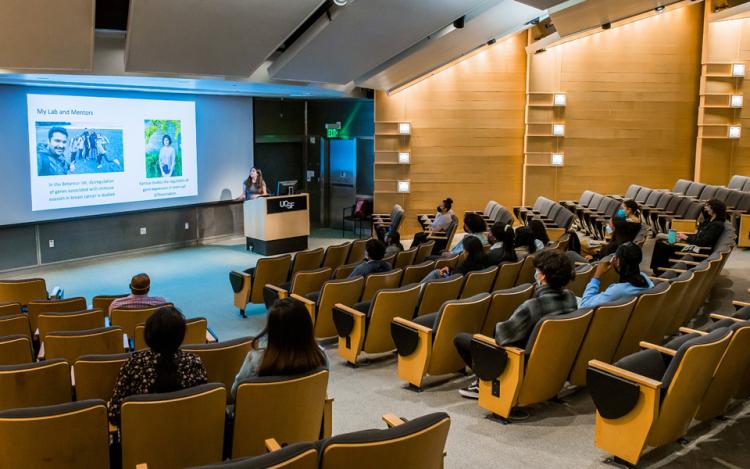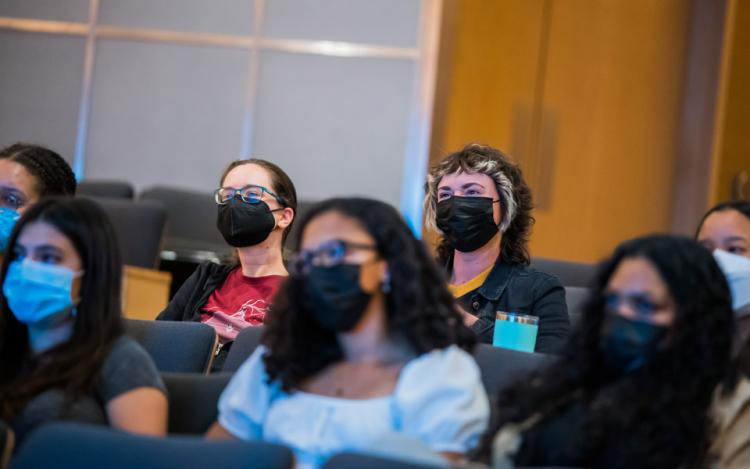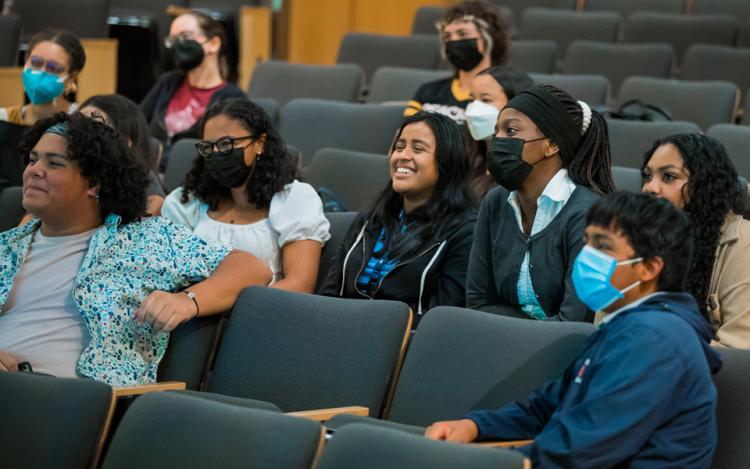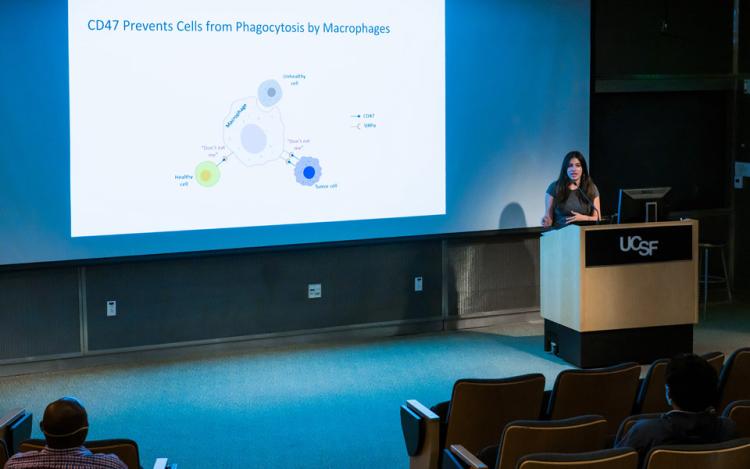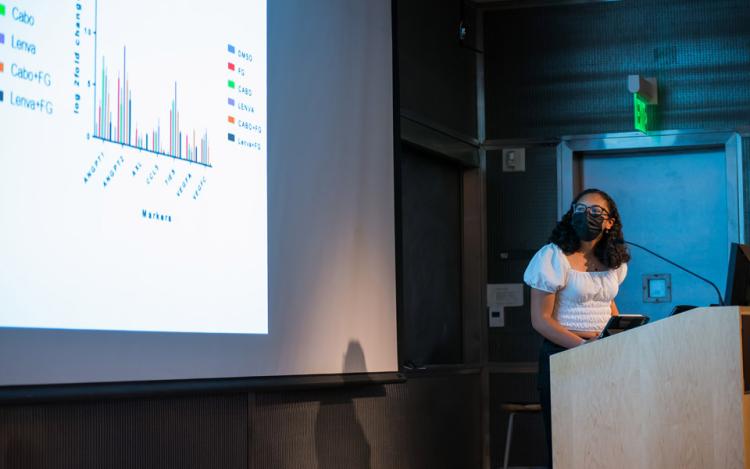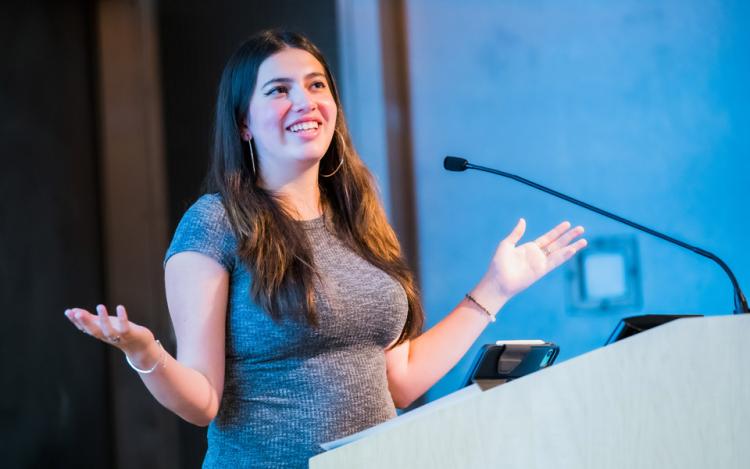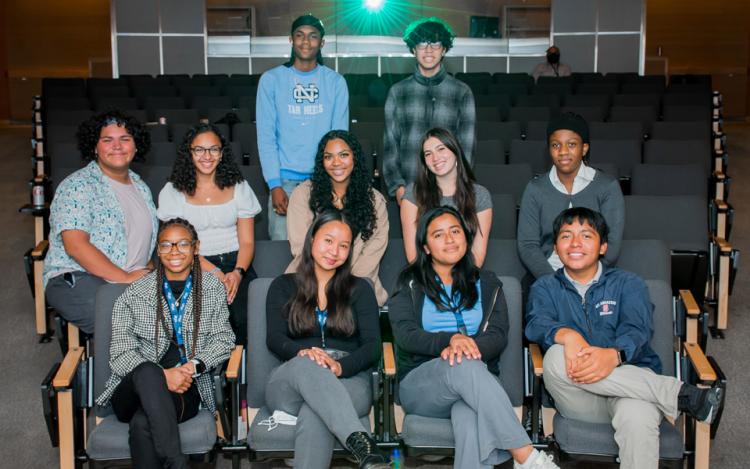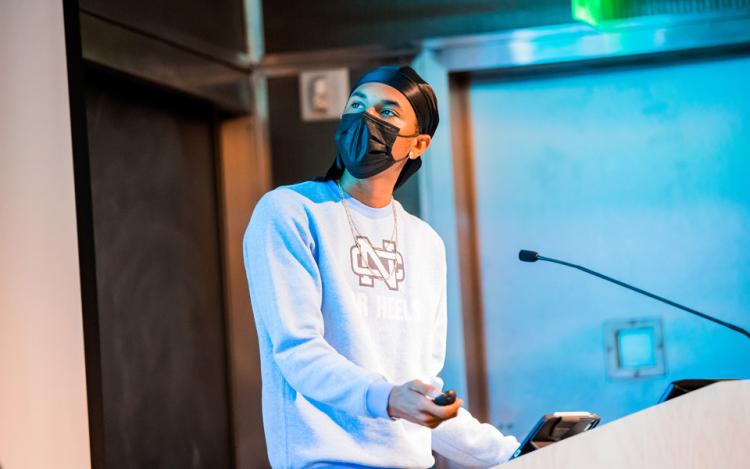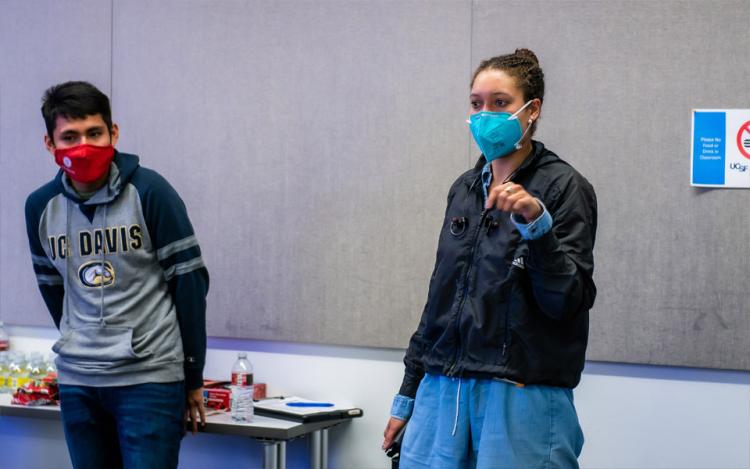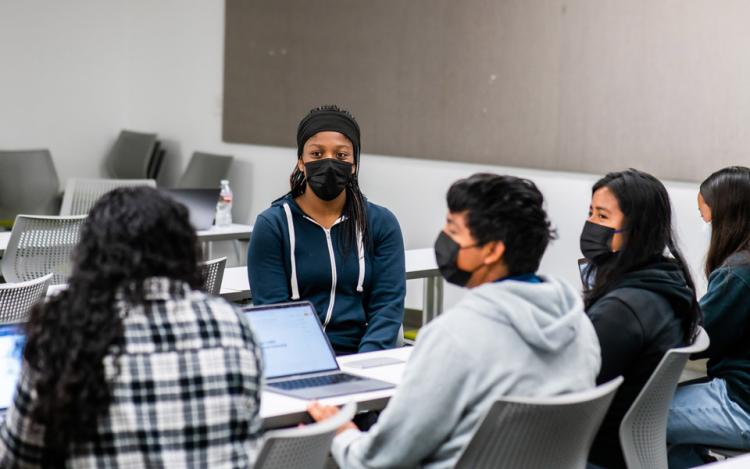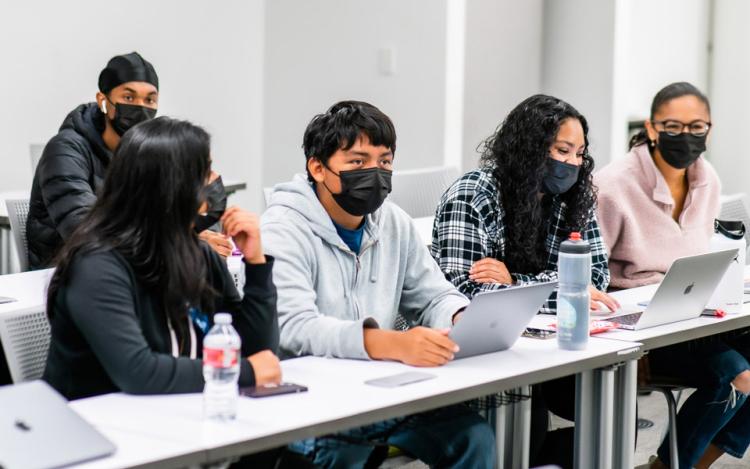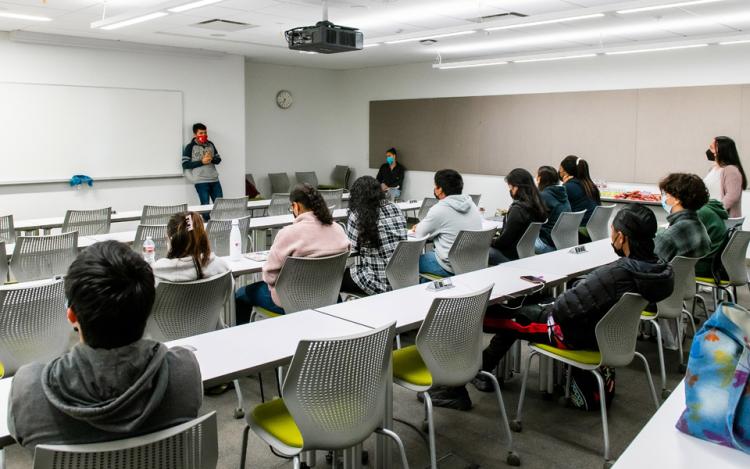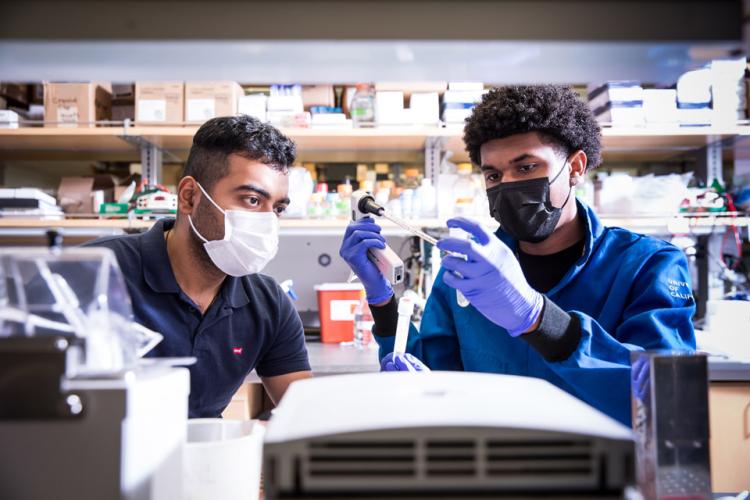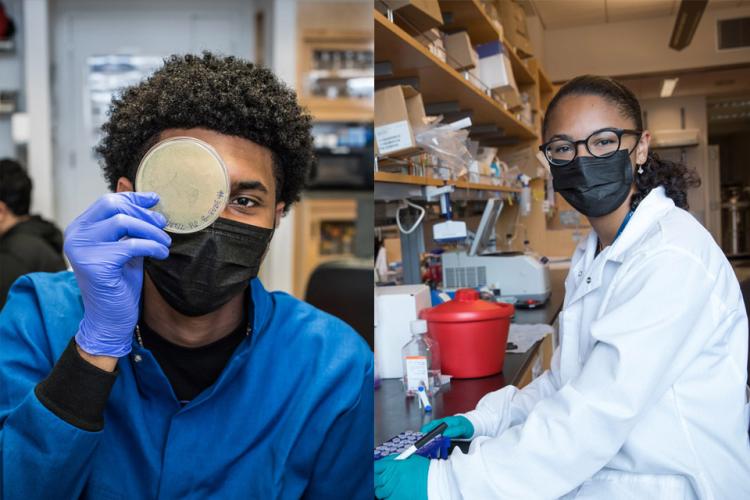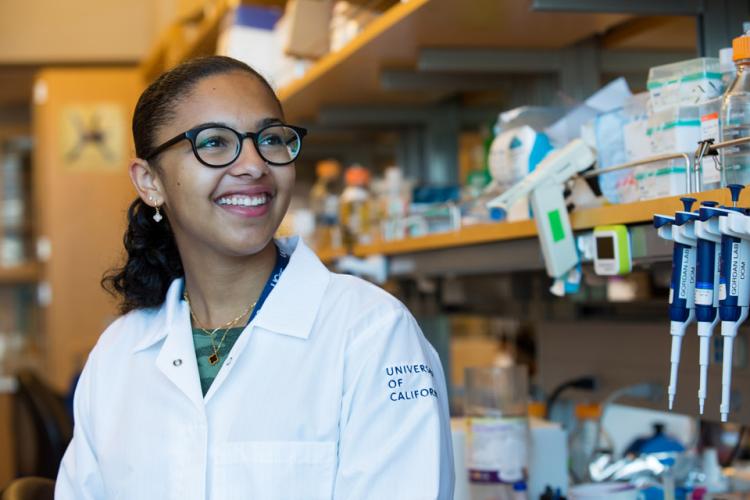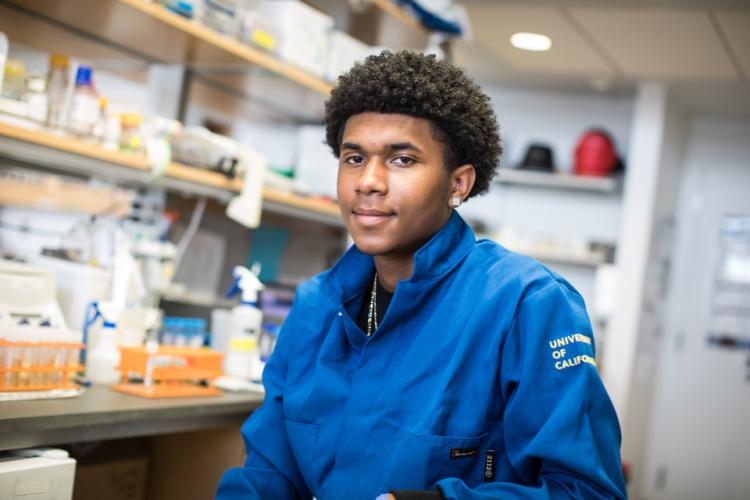UCSF's CURE Internship Program Jumps Back to True Self
The 2022 CURE internship cohort was the sixth iteration of the program and the first held primarily in person since the start of the pandemic in 2020.
By Brian Neumann
A band of high school students took over UC San Francisco’s Byers Auditorium at Mission Bay on a rare brisk, rainy August day.
The students camped in the front rows of the 261-seat auditorium, nervously preparing to give their presentations. UCSF faculty, staff and learners — in other words, the adults for the day — grabbed their seats here and there to take in the show.
The roles were flipped — center stage belonged to the high school students. One by one, they took their turn at the auditorium’s lectern, presenting current research projects happening at UCSF. There were “Creating A Cell Line to Study Chromosome Looping,” “Targeting Genetic Drivers for Treatment of HCC,” and the “Prevalence of Cognitive, Physical, and Sensory Deficits in Medication Management,” among others.
The students’ presentations capped two-month-long paid summer internships organized by UCSF’s Center for Science Education and Outreach (CSEO). The internship program, dubbed CURE, partners high school students from underrepresented backgrounds with different labs at UCSF. The interns conduct research projects with mentors in their respective labs and participate in CSEO-led workshops on college access, future careers and life skills.
The 2022 CURE internship cohort was the sixth iteration of the program and the first held primarily in person since the start of the pandemic in 2020.
CSEO Director Don Woodson, MEd, said the return to in-person internships provides students with a fuller experience.
“The CURE program has absolutely everything to do with the building of confidence and getting these young students to think of themselves as having the ability to [be] in the research space — in this space,” Woodson said. “But [it’s also about] being able to interact with adults in these spaces without fear.
“It’s more difficult to build this confidence when you’re on Zoom,” Woodson continued.
And so the CURE program jumped back into its true self in 2022.
Sally Ume-Ukeje, 17, a CURE intern who attends San Francisco University High School, said she enjoyed the breadth of programming offered — from learning about how to conduct research to field-tripping to eight different labs and panel discussions on career possibilities.
“The program has taught me that you’re not limited in what you can do, and there are so many opportunities out there for you to get involved,” Ume-Ukeje said. “It just showed what you can do with your knowledge.”
Jalen Higgins, 16, a CURE intern who attends June Jordan High School for Equity, echoed Sally’s sentiment about the program. Higgins said he also enjoyed the real-life everyday routine of his research project and being on a university campus.
Higgins said he didn’t want to go to college when he first started high school, but now, after his CURE internship, intends to apply to schools like Morehouse College, UC Berkeley and UC Los Angeles.
“The program… helps you with applying to college and even gives you a deeper look into what you can do after [you graduate],” Higgins said. “My goal is to graduate college and become a research scientist.”
The adults laughed and gave approving head nods; the interns had them hooked. Some interns capped their presentations with reflections on their CURE program journeys: the nervous first days, questioning whether they could catch up with their projects; then the “aha moments” and being able to help run the research experiments and explain them to a large crowd.
“I know the [interns] were going to do great with their presentations,” said Chaney Saephan, Director of the CSEO Transfer Preparation Program. “Seeing them be able to present research that’s being done at UCSF that they have been a part of is unique and special.”
According to Saephan, it was the first time working in a lab for most interns.
“Sometimes in education, you may or may not see the amount of growth in students right away, but I think I saw it right away with our students,” Saephan said. “I saw the confidence; I saw students opening up, being open to learning new things.”
‘Not Just About the Research’
Each Friday during the internship, the interns met as a group for “Friday Sessions,” which covered topics outside their lab work.
On one Friday, it was a panel discussion on different medical careers; another Friday, they dug into financial literacy — credit scores, interest rates, investing — and on a Friday in late July, they demystified the college application process.
Woodson said CURE is “not just about the research.” When he first envisioned the program, Woodson wanted to create an avenue for students to also learn important life skills.
“Over the years, we’ve noticed not only are the ‘Friday Sessions’ something the students pay attention to, but they bring the information home as well,” Woodson said.
For the past two years, Black Excellence in STEM (BE-STEM) at UCSF, a student organization focused on supporting Black and Brown scientists, researchers, postdocs and learners at the institution, partnered with CURE to provide additional mentorship for the students.
According to Christina Stephens, Co-President of BE-STEM at UCSF and graduate student in the Biophysics program in the Grabe lab, a central part of BE-STEM’s mission statement is “to perform outreach and encourage the growth of Black and Brown scientists” in the Bay Area.
Stephens also pointed to the importance of giving the students more opportunities to see themselves represented as scientists and scholars at a world-renowned institution like UCSF.
Ume-Ukeje said that all her mentors during the internship were people of color, something she appreciated.
“It shows that there are people who look like you in the workplace,” Ume-Ukeje said. “The people you meet better your experience, so for me having those people be people of color was definitely a bonus.”
‘Two-Directional Traffic’
For as much as the interns said they gained from their internship, their mentors said they gained just as much from them.
Veriama Pereira, PhD, a postdoctoral research fellow in the Gordan lab at UCSF, called her experience mentoring in an official capacity for the first time “two-directional traffic” in which the students work as equals with their mentors and exchange knowledge and ideas.
“Sally [Ume-Ukeje] inspired me to look and dig deeper, and she has also taught me that you can do whatever your [set] your mind to,” Pereira said.
Pereira also called it a “win-win” situation because the process of explaining different protocols to Ume-Ukeje, helped her, in turn, shed the robot-like nature that can befall researchers when they go over the same steps of an experiment multiple times. To some degree, Pereira said, it was a reminder of the “why” behind these steps.
“The CURE program is a gaining process rather than a giving process,” Pereira said, “because in addition to helping [the students] fit a particular role and help them understand their role, it also helps you understand yourself and your abilities.”
Jennifer Seuferer, MS, the Education and Training Manager for the Helen Diller Family Comprehensive Cancer Center, which has been a long-time supporter and partner of the CURE program, said the interns are valuable additions to UCSF, bringing their perspectives to the real-life research projects they are part of.
The CURE program, Seuferer added, not only provides the students with opportunities but also opens doors for more diverse input, which is a benefit for UCSF and, therefore, the “greater world.”
Seuferer said one shouldn't minimize the knowledge and experience the students bring to the table because they help solve the scientific problems UCSF wants to solve.
“Our world, medicine and science particularly, [is] full of big problems,” Seuferer said. “If we don’t have a diversity of thought and experience to solve those problems, we’re not going to do it.”
Stephens shared similar thoughts: “[The interns] are smart and dedicated. They deserve to be here,” Stephens said. “There’s no other reason why you should want to take them into your lab.”
‘Be that Model’
For Woodson and Saephan, the 2022 CURE internship cohort marked the return to form and then some. Both agree that they want to expand the program while maintaining its core elements.
Woodson said the 2022 cohort welcomed its first students from the Oakland Unified School District; from here, he wants to expand CURE into more labs and into the UCSF Benioff Children's Hospital - Oakland, a step, Woodson said, to provide more accessibility for students living in Oakland and a chance to support their communities.
"We want to bring the program into the East Bay and grow it in terms of the number of students," Woodson said. "But at the same time continuing to have — and evolve — the 'Friday Sessions' to where they all can come together in fellowship."
Saephan said CURE invites more departments at UCSF to join the program and host students. She characterizes CSEO as an "in-between" for high school students and UCSF.
"A lot of times, communities look at higher education institutions to be that model to support them," Saephan said. "So, in a sense, we're consultants for different departments at UCSF to connect their resources and leverage them for the community."
CSEO is now accepting applications for its 2023 CURE internship cohort.
On that rainy August day, the spotlight remained on the 2022 CURE interns.
The 11 interns lined up at center stage, their certificates in hand. The crowd — the adults — cheered. The students took their curtain call.
Ume-Ukeje said she has been veering toward pursuing the medical field, but after being exposed to different types of research and the avenues possible to explore, she is in no rush yet to make a final decision on her future.
“One experience can change the direction of your future,” Ume-Ukeje said, “and that’s what [CURE] did for me; it definitely changed what I know about science and what I’m passionate about.”
For some interns, the next day meant the first last day of high school — more reason to celebrate. Baked goods, fruits and drinks were the order.
The adults now mingled with the students — their chance to claim proximity to some of the youngest researchers, up to that point, UCSF ever had. An honor. ♦
A series of photos showing the 2022 UCSF CURE interns interacting with their mentors and giving presentations, as well as UCSF staff members listening to the presentations.
